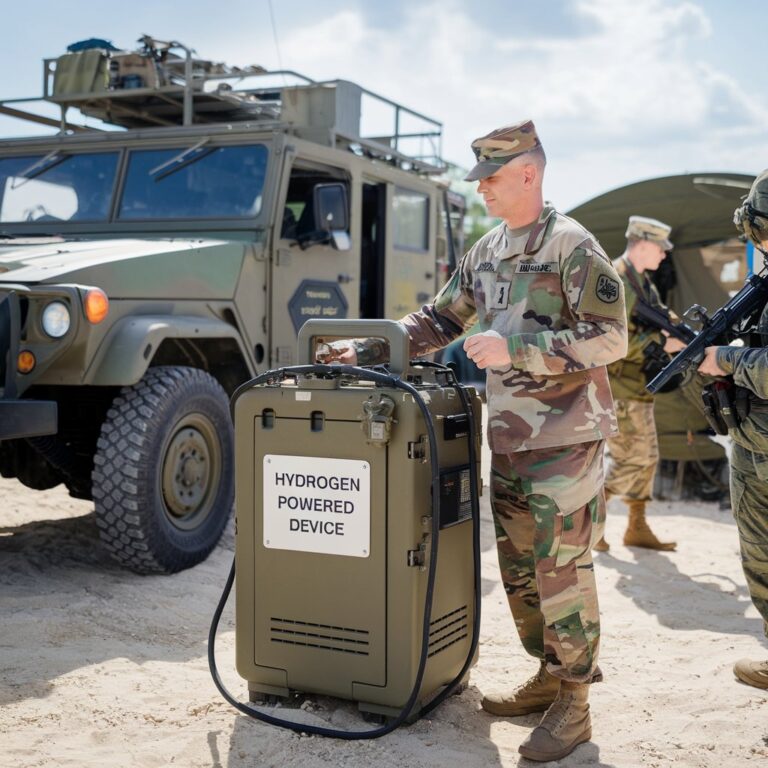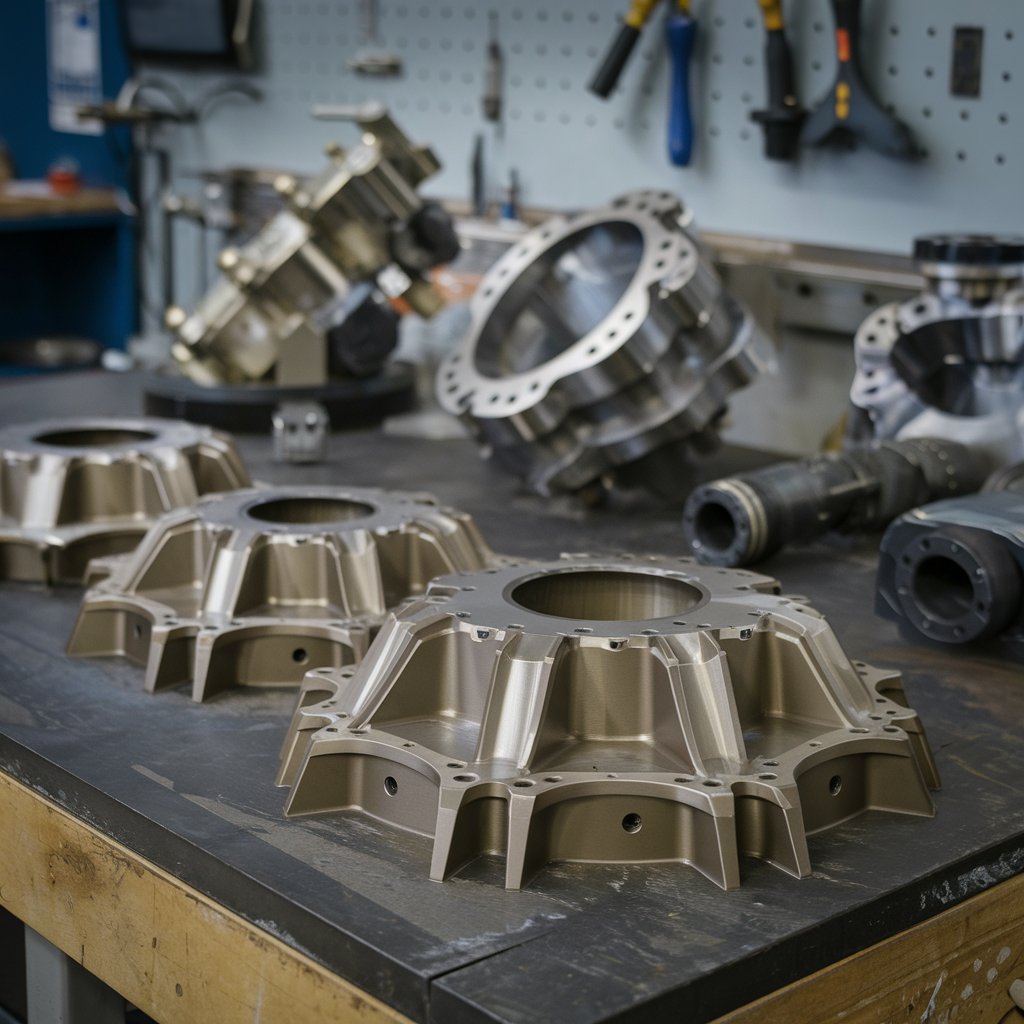CNC Manufacturing of Hydrogen Power Portable Devices for Defense Applications
The demand for portable, reliable, and efficient power sources in defense applications has never been greater. Hydrogen fuel cells, with their high energy density and clean energy output, are emerging as a game-changing solution. Combining hydrogen fuel cell technology with CNC (Computer Numerical Control) manufacturing enables the creation of lightweight, durable, and precision-engineered portable power devices for military use. In this blog, we’ll explore the process, scientific principles, and equations behind this innovative technology.
Why Hydrogen Power for Defense?
- High Energy Density: Hydrogen has one of the highest energy densities by weight, making it ideal for portable devices.
- Stealth Operation: Hydrogen fuel cells operate quietly, reducing acoustic signatures.
- Environmental Resilience: They perform well in extreme temperatures and harsh environments.
- Zero Emissions: The only byproduct is water, making them environmentally friendly.
.

The Role of CNC Manufacturing
CNC manufacturing is critical for producing the precision components required for hydrogen power devices. From fuel cell stacks to hydrogen storage compartments, CNC machining ensures tight tolerances, durability, and repeatability. Let’s dive into the process and the science behind it.
Key Components of a Hydrogen Power Portable Device
- Fuel Cell Stack: Converts hydrogen into electricity through electrochemical reactions.
- Hydrogen Storage System: Stores hydrogen safely and compactly.
- Thermal Management System: Dissipates heat generated during operation.
- Power Management Electronics: Regulates voltage and current output.
- Casing and Structural Frame: Protects internal components and ensures portability.
Scientific Principles and Equations
1.Hydrogen Fuel Cell Operation
The heart of the device is the Proton Exchange Membrane Fuel Cell (PEMFC). The overall reaction in a PEMFC is:
H2=12O2 → H2O+EnergyH2=12O2 → H2O+Energy
The energy output is calculated using the Gibbs free energy change (ΔG) of the reaction:
ΔG = −nFE
Where:
- n = Number of electrons transferred (2 for hydrogen).
- F = Faraday’s constant (96,485 C/mol).
- E = Cell voltage (typically 0.6–0.8 V for PEMFCs).
The theoretical efficiency (η) of the fuel cell is given by:
η=ΔGΔH𝜂=ΔGΔH
Where ΔH is the enthalpy change of the reaction.
2.Hydrogen Storage
Hydrogen can be stored in several ways:
- Compressed Gas: Stored at high pressures (350–700 bar).
- Metal Hydrides: Hydrogen is absorbed into a metal lattice.
- Chemical Hydrides: Hydrogen is released through chemical reactions. The energy density of hydrogen is approximately: Energy Density=120 MJ/kg
Compare this to lithium-ion batteries, which have an energy density of around 0.9 MJ/kg.
3.Thermal Management
Heat generated during fuel cell operation must be dissipated to maintain efficiency. The heat generation rate (Q) can be calculated as: Q=I2R+Inefficiency LossesQ=I2R+Inefficiency Losses
Where:
- I = Current.
- R = Internal resistance of the fuel cell.
Efficient cooling systems, such as microchannel heat exchangers, are essential for maintaining optimal operating temperatures.
4.CNC Machining of Lightweight Materials
CNC machining is used to fabricate components from lightweight materials like aluminum alloys and titanium. The material removal rate (MRR) in CNC machining is given by: MRR=Feed Rate × Depth of Cut × Width of Cut Precision machining ensures components meet tight tolerances, critical for fuel cell performance.
CNC Manufacturing Process
Design and Prototyping
- Use CAD software to design the device, incorporating findings from scientific studies.
- Perform simulations (e.g., thermal, structural) to optimize the design.
- Material Selection
- Choose lightweight, durable materials like aluminum alloys or titanium.
- Ensure materials are corrosion-resistant and thermally conductive.

- CNC Machining
- Fabricate precision components such as fuel cell plates, hydrogen storage compartments, and structural frames.
- Use high-speed machining and advanced tool coatings for optimal results.
- Assembly and Testing
- Assemble the fuel cell stack, hydrogen storage system, and electronics.
- Perform leak tests, power output tests, and environmental stress tests.
Applications in Defense
CNC Machining
- Fabricate precision components such as fuel cell plates, hydrogen storage compartments, and structural frames.
- Use high-speed machining and advanced tool coatings for optimal results.
Assembly and Testing
- Assemble the fuel cell stack, hydrogen storage system, and electronics.
- Perform leak tests, power output tests, and environmental stress tests.
Challenges and Future Directions
- Hydrogen Safety: Robust leak detection and safety mechanisms are essential.
- Cost Reduction: Advances in manufacturing and materials are needed to reduce costs.
- Energy Density: Research into advanced hydrogen storage methods is ongoing.
How CIMtech Can Help in Making CNC Manufacturing Parts for Defense Applications
CIMtech excels in CNC manufacturing, delivering high-accuracy, precision-engineered components for defense applications. Our advanced technology and expertise make us a trusted partner for producing hydrogen power portable devices and other critical defense systems. Here’s how we can help:
- Precision and Accuracy
Tight Tolerances: Our CNC machines achieve tolerances as tight as ±0.001 mm, ensuring components meet exact specifications.
Advanced CAD/CAM Software: We use cutting-edge software for design and simulation, optimizing performance and durability.
Quality Assurance: Rigorous testing, including CMM and laser scanning, guarantees top-tier quality.
2.Advanced Technology
5-Axis CNC Machining: Enables complex geometries for components like fuel cell plates and thermal systems.
High-Speed Machining: Reduces production time while maintaining exceptional finish and accuracy.
Material Expertise: We specialize in lightweight, durable materials like aluminum alloys and titanium.
3.Custom Solutions
Prototyping and R&D: We collaborate with defense contractors to develop and refine prototypes.
Small-Batch Production: Ideal for low-volume, high-precision needs.
End-to-End Services: From design to assembly, we streamline the manufacturing process.
4.Defense Applications
Fuel Cell Components: Precision machining of fuel cell stacks, hydrogen storage, and thermal systems.
Soldier-Worn Systems: Lightweight, durable casings for portable power devices.
UAVs and Robotics: High-precision parts for drones and robotic systems.
5.Why CIMtech?
Proven Expertise: Over 60,000+ fuel cell devices in real-world applications.
Defense Industry Focus: We understand the unique challenges and deliver reliable, high-performance solutions.
Innovation-Driven: We invest in the latest technology and collaborate with research institutions to stay ahead.
The combination of hydrogen fuel cell technology and CNC manufacturing is transforming portable power solutions for defense applications. Hydrogen fuel cells offer high energy density, stealth operation, and environmental resilience, making them ideal for military use. CNC manufacturing ensures precision, durability, and lightweight design for critical components like fuel cell stacks and thermal systems.
CIMtech excels in delivering high-accuracy CNC-machined parts, leveraging advanced technology and materials to meet defense needs. Our expertise supports the development of reliable, efficient hydrogen power devices for soldier-worn systems, UAVs, and field operations. Together, we’re driving innovation and sustainability in defense energy solutions.
Scientific Studies Supporting the Technology
PEMFC Efficiency Improvements:
- Study: “Recent Advances in PEMFC Technology for Portable Applications” (Journal of Power Sources, 2021).
- Key Finding: Advanced catalyst materials and membrane designs have improved PEMFC efficiency by 20%.
Hydrogen Storage Innovations:
- Study: “Hydrogen Storage Technologies for Portable Fuel Cells” (International Journal of Hydrogen Energy, 2020).
- Key Finding: Metal hydrides offer a safe and compact storage solution for portable devices.
Thermal Management Strategies:
- Study: “Thermal Management in Portable PEMFC Systems” (Applied Thermal Engineering, 2019).
- Key Finding: Microchannel cooling systems reduce operating temperatures by 15–20%.
CNC Machining of Advanced Materials:
- Study: “CNC Machining of Lightweight Alloys and Composites” (Journal of Manufacturing Processes, 2021).
Key Finding: High-speed machining improves surface finish and reduces production time.
References
- Journal of Power Sources, “Recent Advances in PEMFC Technology for Portable Applications” (2021).
- International Journal of Hydrogen Energy, “Hydrogen Storage Technologies for Portable Fuel Cells” (2020).
- Applied Thermal Engineering, “Thermal Management in Portable PEMFC Systems” (2019).
- Journal of Manufacturing Processes, “CNC Machining of Lightweight Alloys and Composites” (2021).
CIMtech HydrogenPower CNCManufacturing DefenseInnovation

